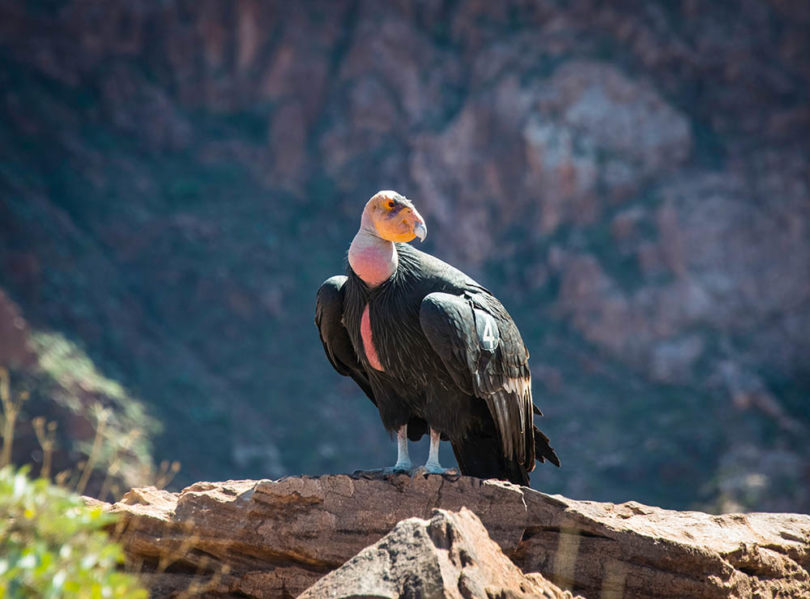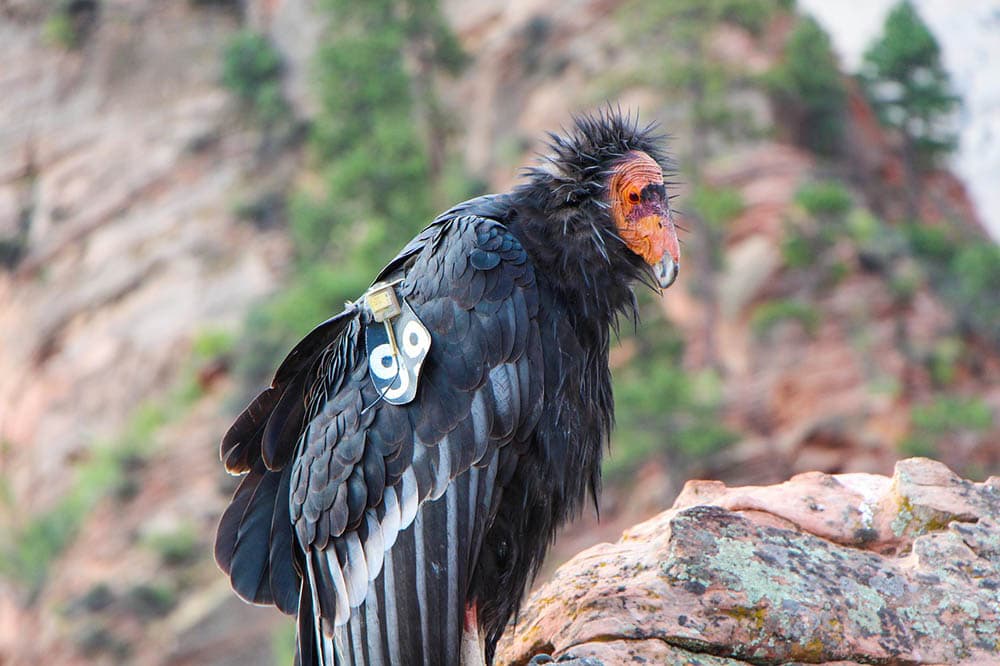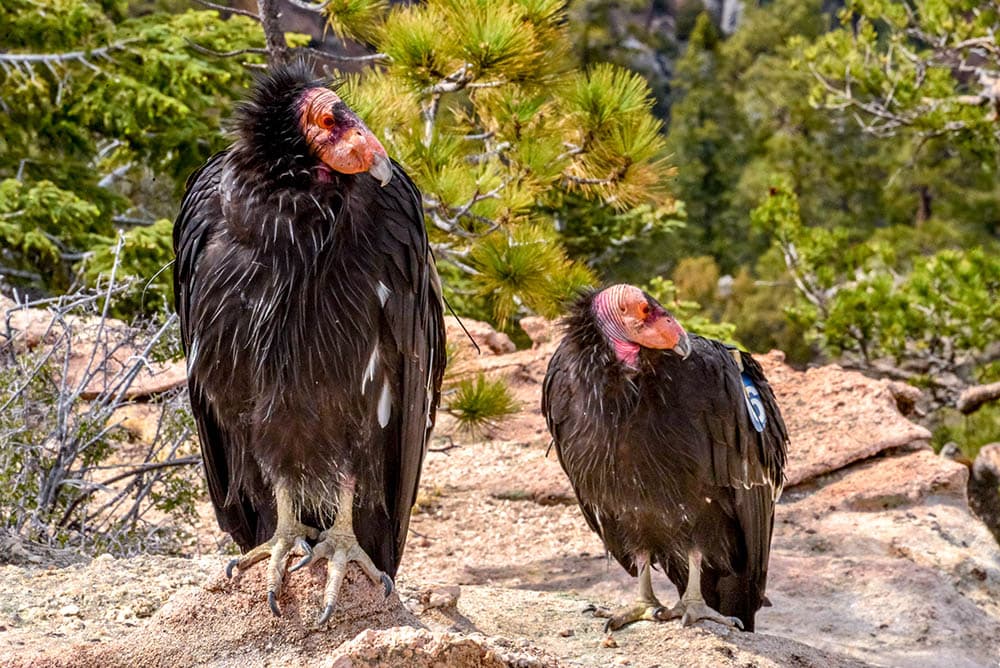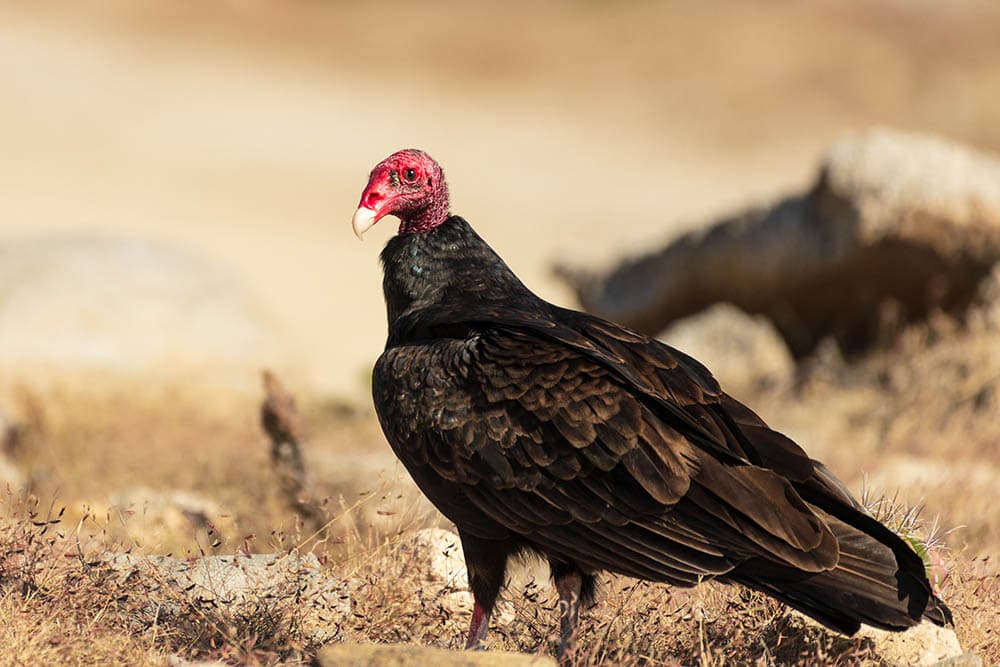23 Fascinating & Fun California Condor Facts You Never Knew
Last Updated on

Here’s something that a lot of you probably don’t know: Back in the day, the California condor could only be spotted in Mexico and Canada. But so much has changed since then, including their habitats.
Today, you’ll only be able to see a condor stretching its wings in the skies of the southern parts of Utah, around the Grand Canyon, or in California.
We thought we should brighten your day by sharing this and several other fun facts about the California condor.

The 23 Facts about the California Condor
1. The scientific name of the California condor is Gymnogyps californianus.
‘Gymno’ is a Greek word that’s often used to refer to bare or naked, while ‘gyps’ is the name given to the vulture. ‘Californianus’, on the other hand, came from California, its present location of residence.
‘Condor’ is a hispanicized version of the word kuntur. It’s a word found in the Quechua language, spoken by the South American Indians. These people have called the Andean highlands home for a very long time.

2. A California condor is a known scavenger.
Birds classified as scavengers usually consume decaying biomass. What that means is, their main diet will mostly consist of rotting meat and various plant materials.
Because they prefer meat to plants, they are sometimes classified as carnivores as well. However, they rarely do hunt or kill any prey, since their features — especially talons and beaks — aren’t as strong as those gifted to different birds of prey.
For obvious reasons, people don’t like associating themselves with these birds, or even being seen around them. But if you think about it, they are good for our environment. Just imagine living in an ecosystem that has rotting carcasses every corner you turn to, with no one to clean them up.
That would mean constantly having to deal with harmful pathogens that are detrimental to our health. Also, in case you’re wondering, some of the known diseases caused by the said pathogens are so hard to cure.
3. These birds belong to Class Aves.
We do have different classes of vertebrates, and the Class Aves is one of them. In this group, you’ll find very many bird species and subspecies, with their sizes ranging from 1.97 inches (the bee hummingbird) to 108.27 inches (the ostrich).
What attributes make the California Condor part of the Class Aves family?
They are homoiothermous, and bipedal feathered. Homoiothermous is the scientific term used to describe all living organisms that can maintain a constant body temperature, even if the temperatures in their immediate surroundings keep fluctuating. So, we’re mostly referring to mammals and birds.
Bipedal feathered means exactly what you think — the two forelimbs are wings, and their prime function is to help the bird fly. Well, except for a few flightless birds, like the ostrich.
The alimentary canal (food pathway) is different in the sense that it has a gizzard, crop, and a few extra chambers. The sole function of the crop is to store and soften the food, while the gizzard crushes and churns it.
When it comes to the respiratory system, they completely rely on their lungs. These lungs are spongy, but weirdly inelastic. Fortunately, they have air sacs connected to those lungs, so as to supplement respiration.
The California condor and all the other bird species that fall under this class do have larynxes (voice box) just like most animals. But they don’t quite use them. If they want to communicate with each other, or other birds, they’ll produce different sounds using something called the syrinx.
In comparison to reptiles, their brains are better developed. and this is even though they are relatively small in size. We’ve studied them for quite a long time to ascertain that their optic lobes, cerebellum, and cerebrum are exceptionally large.
Typical of a scavenger, their sense of sight is just as good as that of a raptor, but their sense of smell is so poor.
4. The California condor doesn’t lay eggs quite as often.
Unlike most birds, the California condor starts breeding once it gets to the ages of six, seven, or eight. They are never in a rush to breed, and quite frankly, we don’t really know why. Some researchers believe that this could be due to the harsh conditions that are quintessential to their habitats, but the jury is still out on that one.
When the time’s right, the female condor will lay just one egg. One egg in a single nesting attempt, and then probably skip the next year, to ensure their last offspring is well taken care of.
Assuming that egg fails at the beginning of the breeding season, or inadvertently breaks, it will probably lay a second one as its replacement. The male condor will chip in and help with other responsibilities, including feeding and incubation.
The California condor’s baby will start practicing flying after five to six months. And it will keep practicing for almost two years, a time when it feels ready to scavenge without the help of its parents.
5. California Condors don’t build nests.
If you’re not acquainted with the California condor’s nesting behavior, you’ll think it’s a brood parasite. Birds classified as brood parasites don’t like building nests or taking care of their young ones.
They’ll casually look for a different species’ nest, sneak in when they are away hunting or feeding, and then lay their eggs there.
The disinterest in building a nest is what first led us to believe that the California condor is a brood parasite. That is until we realized that it doesn’t really need a nest to lay eggs. It will just look for a rocky place that feels secure, push away the unwanted rocks, and then do its thing.
6. Condors are among the most intelligent birds on the planet.
To understand the level of intelligence of any bird, you first must take time to study its different responses to sensory stimuli. And the condor always excels in that department. If you spot a group of them — which is rarely the case since they prefer not to hang out in groups — they’ll be busy playing. They’ll keep engaging themselves in different games, including tug of war, and fetch.

7. It’s a curious species.
Naturally, birds don’t see us, humans, as friends. And that’s the reason why they keep flying away even if we’re trying to feed or pet them.
The California condor is different in that it will first try to study your intentions or behavior. It obviously knows you’re a predator, but its curious nature will compel it to first gather more information before flying away.
8. They growl, grunt, and hiss.
If the California condor spots a stranger or intruder near its nesting ground, it will hiss. That’s their way of communicating with anyone or anything that’s trying to interrupt their breeding process, and/or threaten them.
Assuming they feel intimidated by a different species, they’ll again hiss. And they’ll keep producing the same sound until that animal or bird leaves them alone.
Growling and grunting are the sounds they produce during mating season, or while communicating with their young ones.
Sometimes they don’t even have to produce any sound while trying to communicate with each other because they have a body-language system that’s incredibly developed.
9. They have a very effective immune system.
We don’t know if you knew this, but nearly all birds have the potential of carrying diseases without having to get sick or even showing symptoms. As a matter of fact, there’s a study that recently revealed how birds rely on the macrophages found in their blood system to guard themselves against disease-causing pathogens.
These macrophages give them the ability to block the growth of cryptococci, as well as the development of other bacteria.
By the way, Cryptococci is a particular fungus that somehow always finds its way into a bird’s digestive tract. And the macrophages that we are referring to, are a type of white blood cells. These two are like adversaries because the minute the fungus tries to gain access into the bird’s system, the macrophages will be released and fight back to protect the bird.
Although that explains why most birds will look healthy while still being infectious, it doesn’t quite explain why the California condor is able to fight off diseases that affect nearly all birds. Especially considering they are scavengers, a species that’s at a higher risk of encountering nasty bacteria, every time they go out hunting or feeding.
But seeing as so little is still known about the avian immune system, we’ll stop speculating, and leave it at that.
10. They groom quite often.
Feather maintenance is so important to the California condor. They like to maintain their good feather condition through preening, or bathing in dust. If they aren’t hunting, feeding, or taking care of their young ones, they’re preening.
And they’ll spend several hours preening because they know every body part that’s covered with feathers has to be waterproofed. The preen oil being utilized in this process is normally drawn from the uropygial gland, located at the base of its tail.
Dust bathing sounds counterproductive on paper, but it’s so effective when the bird’s trying to eliminate all the extra lipids. From time to time, you’ll see the condor lie on the ground and work the dust through its feathers, before standing up and shaking off the excesses from its plumage.
Any other area that doesn’t have feathers will be rubbed on branches, rocks, or grass, right after it’s done feeding.
11. Contrary to popular belief, the California condor spends most of its time roosting and not flying.
Some people prefer calling it sunning, but it can also be called roosting. It’s through this process that they are able to drive out all parasites hiding within their plumage.
To ensure the sun’s heat gets to those hard-to-reach places, they’ll adopt this awkward posture that allows its body feathers to fluff up, while the wings are all spread out. And this is something that they’ll still do even if they feel well-preened.
You might also be interested in: 53 Fascinating & Fun Owl Facts You Never Knew
In the bird community, we have two styles of monogamy. The first one is where two birds only pair up during the breeding season, and part ways immediately after that season ends. They’ll then seek out new partners in the next breeding season and start the whole courting process afresh.
The second style is where two birds pair up and become life partners. The only time you’ll see them seeking new partners is when one of the partners goes missing without notice (probably killed), or if the pairing was unsuccessful.
The California condor subscribes to the second style.

In many ways, the California condor is just like us humans. And this can once more be seen in how they socialize with one another while hanging out in groups. They’ll make these different body postures that are not only meant to act as cues, but also acknowledge and maintain social hierarchies.
14. It’s a dominant scavenger.
Anytime you visit their feeding ground, you’ll find more than one scavenger species. But the California condor will always stand out, as it reigns supreme in that community. The only time you’ll see a condor fly away and leave food behind, is when a Golden eagle approaches.
The thing is, even though the condor is heavier and probably stronger than the eagle, the talons that the Golden eagle possesses are not to be trifled with. And that’s the other reason why you’ll see many scientists place the California condor below the Golden eagle in any food web.
15. Condos can survive for long periods without food.
More times than not, different bird species will migrate to other regions should they sense their food stores are running low. But not the California condor. Their bodies are equipped with everything they’ll need to survive during such periods, and they know this.
For starters, there’s the crop that’s basically a storage site for all the excess food consumed during a hunt. This muscular pouch is found around the neck region, at the top of the sternum.
A female California condor that has a baby to feed will produce milk using its crop, if its resources are depleted. Nevertheless, that doesn’t mean that crop milk is actually milk. It’s essentially the crop’s cell lining secretion, and it has the texture of milk.
Their fat stores are also vital during this period. They’ll gradually build up fat stores whenever food is readily available, and then slowly burn through them when their energy needs are higher than what their bodies are getting.
Size is also a factor here. It’s been documented on several occasions that large birds find it easy to survive in the wild without food, as opposed to smaller birds. Therefore, if a small species can go one week without a meal, a larger one will probably go two or more.
Taking all these factors into account, we hope you now understand why the California condor can go for up to two weeks without having a single meal. Not even water.
16. Flying and landing don’t come easy to a baby condor.
The condor’s chicks are not the quickest learners when it comes to flying or landing. By the way, we still stick by what we said earlier on when we told you that they are intelligent birds. It’s just that they always underperform while learning how to fly or land.
So don’t be shocked to see a baby condor crash-land four to five months after learning how to take flight.
But on a positive note, once they get the hang of it, they’ll look like naturals. And the adults have an impeccable soaring and flying ability, judging by how well they soar without flapping their wings over long distances.
17. They have no real predators.
Other than humans, we cannot think of any bird or animal that preys on the California condor. And if there is, it’s not yet documented anywhere. They still must deal with Golden eagles and Ravens that sometimes intrude and attack the chick while it’s resting in its nest.
You might also be interested in: 12 Fascinating & Fun Falcon Facts You Never Knew
18. The color of a California condor’s egg is bluish-white.
You’ll never mistake the condor’s egg for any other egg, as it has a distinctive bluish-white color. The egg’s size is nowhere as large as that of an ostrich if that’s what you were thinking. It’s what you’d consider average, but very beautiful.
19. It’s larger than all birds in North America.
We don’t know what changed, but this species used to be revered by other species. The fact that it’s a scavenger was a turnoff, but the way it dominated the skies in the west made so many bird species feel intimidated to a certain degree.
A California condor can grow to be as big as 44 to 55 inches, with a wingspan that ranges 8.2 to 9.5 feet. They are also quite heavy, as they would weigh anything from 15 to 31 lb. That means if you put a California condor next to a turkey vulture, the vulture will look like a juvenile condor.
20. The condor’s bald head is an adaptation.
Crazy as this might sound, the California condor’s head doesn’t have any feathers because of what it prefers to eat. It often sticks its head inside carcasses while feeding, so you can imagine how difficult it would have been to clean if it had feathers all over.
21. It’s sometimes referred to as the New World Vulture.
Regardless of what people think, the New World Vultures are very different from the Old. They obviously share several attributes, but that doesn’t mean that they’re genetically close.
Their uncanny similarities are caused by something that scientists like to refer to as Convergent Evolution. It’s an evolution where two very different groups of animals or birds evolved separately to occupy a given ecological niche.

22. If the California condor feels like cooling itself, it will do so through urohidrosis.
Because the bird doesn’t perspire the same way as humans, it often poops or urinates on its legs anytime it feels the need to cool down. And this process is beneficial in more than one way since it also kills any sort of bacteria that they track around after meeting contaminated flesh.
23. Condors are close to extinction.
In 1980, it was discovered that the California condor was on the brink of extinction. The thought of losing another bird to extinction was so scary that various conservation groups from all walks of life came together to figure out a quick solution to this problem.
The first thing they did was to study/observe the bird’s nesting behavior. That’s when they learned that this species always lays a second, and sometimes third egg if the first one breaks or is removed.
This discovery was what birthed the idea of captive incubation. They would steal the egg while the bird and partner were away hunting for food and incubate them in their laboratories.
But this was just the first step to saving the species. The next step was to draft a law that would make it illegal to hunt, kill, or try to domesticate the California condor anywhere. It obviously took longer than expected, but that law finally came into full effect two years ago.
You might also be interested in:

Wrapping Up
Learning about the California condor made us believe there’s so much to learn about our ecosystem and the various organisms that are part of it. So, if you have anything to share or contribute, kindly reach out.
Also, do you have more facts that you’d like to add? Just send us a message.
Featured Image Credit: Georgi Baird, Shutterstock
Table of Contents
- The 23 Facts about the California Condor
- 1. The scientific name of the California condor is Gymnogyps californianus.
- 2. A California condor is a known scavenger.
- 3. These birds belong to Class Aves.
- 4. The California condor doesn’t lay eggs quite as often.
- 5. California Condors don’t build nests.
- 6. Condors are among the most intelligent birds on the planet.
- 7. It’s a curious species.
- 8. They growl, grunt, and hiss.
- 9. They have a very effective immune system.
- 10. They groom quite often.
- 11. Contrary to popular belief, the California condor spends most of its time roosting and not flying.
- 12. Their social systems are complex at best.
- 13. There’s a social hierarchy in every group.
- 14. It’s a dominant scavenger.
- 15. Condos can survive for long periods without food.
- 16. Flying and landing don’t come easy to a baby condor.
- 17. They have no real predators.
- 18. The color of a California condor’s egg is bluish-white.
- 19. It’s larger than all birds in North America.
- 20. The condor’s bald head is an adaptation.
- 21. It’s sometimes referred to as the New World Vulture.
- 22. If the California condor feels like cooling itself, it will do so through urohidrosis.
- 23. Condors are close to extinction.
- Wrapping Up
About the Author Robert Sparks
Robert’s obsession with all things optical started early in life, when his optician father would bring home prototypes for Robert to play with. Nowadays, Robert is dedicated to helping others find the right optics for their needs. His hobbies include astronomy, astrophysics, and model building. Originally from Newark, NJ, he resides in Santa Fe, New Mexico, where the nighttime skies are filled with glittering stars.
Related Articles:
How to Clean a Refractor Telescope: Step-by-Step Guide
How to Clean a Telescope Eyepiece: Step-by-Step Guide
How to Clean a Rifle Scope: 8 Expert Tips
Monocular vs Telescope: Differences Explained (With Pictures)
What Is a Monocular Used For? 8 Common Functions
How to Clean a Telescope Mirror: 8 Expert Tips
Brightfield vs Phase Contrast Microscopy: The Differences Explained
SkyCamHD Drone Review: Pros, Cons, FAQ, & Verdict
